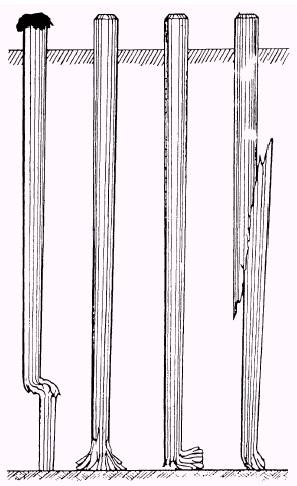Hello,
I'm doing a deep dive into some pile types. Regarding timber piles, I often hear that they are considered friction piles and their end bearing is ignored in capacity calculations. However, this is always just stated, but never justified. The best I could find was this quote from the 2015 Timber Pile Design and Construction Manual by the Timber Piling Council:
"The equations presented here assume that both the pile toe and shaft have moved a sufficient distance with respect to the adjacent soil to simultaneously mobilize the ultimate shaft and toe resistance. It should be noted that the displacement needed to mobilize the shaft resistance is generally smaller than that required to mobilize the toe resistance."
Unfortunately no further details are given. It seems to me that his is very poor justification for completely ignoring a potentially large contribution to capacity from end bearing. I have a few questions. If you can only answer some that's still great.
1) Does this apply in all soils? The quote does say "generally"...
2) Does this apply to other tapered piles such as tapered steel pipe piles?
3) Presumably, if the friction capacity is exceeded, the pile would slide a microscopic bit and mobilize enough to engage end bearing. At this point, friction isn't completely gone. It's probably still significant. Why not consider this state when designing, especially if the tip is in a dense soil layer capable of providing good end bearing?
Thanks.
I'm doing a deep dive into some pile types. Regarding timber piles, I often hear that they are considered friction piles and their end bearing is ignored in capacity calculations. However, this is always just stated, but never justified. The best I could find was this quote from the 2015 Timber Pile Design and Construction Manual by the Timber Piling Council:
"The equations presented here assume that both the pile toe and shaft have moved a sufficient distance with respect to the adjacent soil to simultaneously mobilize the ultimate shaft and toe resistance. It should be noted that the displacement needed to mobilize the shaft resistance is generally smaller than that required to mobilize the toe resistance."
Unfortunately no further details are given. It seems to me that his is very poor justification for completely ignoring a potentially large contribution to capacity from end bearing. I have a few questions. If you can only answer some that's still great.
1) Does this apply in all soils? The quote does say "generally"...
2) Does this apply to other tapered piles such as tapered steel pipe piles?
3) Presumably, if the friction capacity is exceeded, the pile would slide a microscopic bit and mobilize enough to engage end bearing. At this point, friction isn't completely gone. It's probably still significant. Why not consider this state when designing, especially if the tip is in a dense soil layer capable of providing good end bearing?
Thanks.

